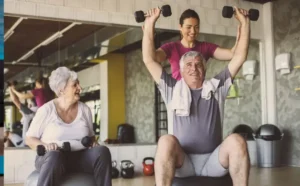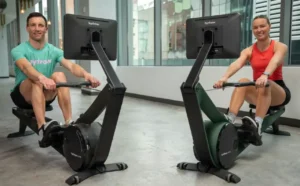As individuals age, they often face various health challenges, including osteoporosis and arthritis. These age-related conditions can significantly impact quality of life, causing pain, decreased mobility, and increased risk of fractures. Whole Body Vibration (WBV) machines have emerged as a promising tool to help manage these conditions, offering a non-invasive and effective approach to improving bone density, joint function, and overall physical well-being.
Understanding Osteoporosis and Arthritis
Osteoporosis is characterized by reduced bone mass and deterioration of bone tissue, leading to fragile bones and an increased risk of fractures. It is particularly common in postmenopausal women due to hormonal changes that affect bone density.
Arthritis encompasses a range of conditions that cause inflammation and stiffness in the joints. The most common forms are osteoarthritis, which results from wear and tear of the joint cartilage, and rheumatoid arthritis, an autoimmune disorder that targets the synovial membrane of the joints.
The Role of WBV Machines in Osteoporosis Management
1. Enhancing Bone Density: WBV machines stimulate bone formation by transmitting mechanical vibrations through the body. These vibrations create small, rapid forces that mimic the effects of weight-bearing exercise, which is known to promote bone health. Studies have shown that regular use of WBV machines can lead to increased bone mineral density (BMD), particularly in the spine and hips, areas commonly affected by osteoporosis.
2. Improving Balance and Reducing Fall Risk: Osteoporosis increases the risk of fractures from falls. WBV machines improve muscle strength, coordination, and balance, helping to reduce the likelihood of falls. By engaging the muscles of the lower body, WBV sessions enhance proprioception and stability, which are crucial for fall prevention.
3. Pain Reduction: Some studies suggest that WBV therapy can reduce pain associated with osteoporosis. The gentle vibrations can help alleviate discomfort by increasing blood flow and promoting relaxation of tense muscles.
The Role of WBV Machines in Arthritis Management
1. Reducing Joint Pain and Stiffness: WBV machines can help manage arthritis symptoms by reducing joint pain and stiffness. The vibrations increase blood circulation to the affected joints, enhancing the delivery of oxygen and nutrients while removing metabolic waste products. This can lead to a reduction in inflammation and pain.
2. Enhancing Muscle Strength and Flexibility: Arthritis often leads to muscle weakness due to decreased physical activity. WBV therapy can improve muscle strength and flexibility, which are essential for supporting and stabilizing arthritic joints. Stronger muscles help alleviate the load on joints, reducing pain and improving function.
3. Promoting Cartilage Health: Some research indicates that WBV therapy may have a positive effect on cartilage health. By stimulating the production of collagen and other extracellular matrix components, WBV machines can potentially slow the progression of cartilage degeneration in osteoarthritis.
4. Improving Mobility and Function: Regular use of WBV machines can enhance overall mobility and function in individuals with arthritis. The increased muscle strength, flexibility, and reduced pain contribute to better joint function, allowing individuals to perform daily activities with greater ease.
Practical Considerations and Safety
1. Supervision and Guidance: It is essential for older adults to use WBV machines under the guidance of a healthcare professional or a trained therapist, especially when managing osteoporosis or arthritis. Proper supervision ensures that the vibrations are used at safe and effective levels, tailored to the individual’s condition and capabilities.
2. Gradual Progression: Starting with lower vibration frequencies and shorter session durations is recommended, gradually increasing as the body adapts. This approach minimizes the risk of injury and ensures that the therapy is well-tolerated.
3. Contraindications: While WBV machines offer numerous benefits, they may not be suitable for everyone. Individuals with certain medical conditions, such as deep vein thrombosis, severe cardiovascular disorders, or recent surgeries, should consult their healthcare provider before using WBV machines.
Conclusion
Whole Body Vibration machines provide a valuable tool in managing age-related conditions like osteoporosis and arthritis. By enhancing bone density, reducing pain, improving balance, and promoting overall joint health, WBV therapy can significantly improve the quality of life for older adults. However, it is crucial to approach WBV therapy with proper guidance and caution to maximize its benefits while ensuring safety. As research continues to explore the potential of WBV machines, they hold promise as an integral part of comprehensive care for managing osteoporosis and arthritis.



